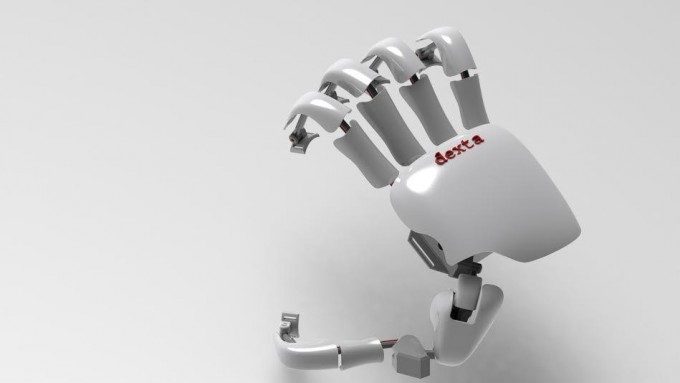Dexta Robotics is pioneering what they see as the next logical step for immersive experiences, being able to touch the virtual world, and to feel it push back. Their Dexmo VR gloves are designed to provide resistance to the wearer, corresponding to their interaction with the VR environment. In this guest post, Dexta Robotics founder Aler Gu brings us up to date with Dexmo’s progress.


VR is now on everybody’s mind. Immersive technology that stimulates sight and sound are promising and progressing quickly. But touch is the key to immersion. To feel and interact with virtual objects is to reach across the digital divide.
True force feedback has been possible in a lab. But only with large, loaded motors. Cumbersome, expensive, untenable for mass markets. The idea behind Dexmo is to make force feedback light, affordable and workable.
The key is binary force feedback. Intelligently-controlled slider mechanisms in the exoskeleton that lock and unlock joints. This technique provides force feedback at the individual finger level in VR. The tech also captures hand motion in 3D space. The combination is satisfying and affordable. Portable and wireless.
Binary, in this context, refers to the two states of the force feedback unit (FFU) on each finger exoskeleton: on and off. When the FFU is in off state, users can move their fingers. Dexmo tracks their finger movement. Unlike other feedback devices, it doesn’t need the motor to take all the torque the user applies. That works to simulate absolute rigid force feedback but doesn’t work for springy feedback. (The middle part of the force output spectrum.) That’s why Dexta developed another Dexmo prototype with variable stiffness, to explore other possibilities.
Dexta has a granted and sealed US patent for the technology that makes this possible, and our research has been published in SIGCHI. The progress we’ve made is tangible, and we’re excited about it. The below video, which we’ve moved far beyond, provides a glimpse at what we’re trying to achieve and how our technology looks in use.
With this technology and knowledge, we’re refining the binary force feedback to include softness. This approach relies on careful impedance control stiffness adjustments. The video at the top of the article demonstrates this.
We control the motor to act as a spring. The stiffness of the “spring” adjusts electronically in real-time, controlled by the application. This control method is standard in collaborative robotics, a field focusing on human augmentation through robot apparatus. Japanese research teams had similar ideas, but they never pushed it to market. Dexta is the first to apply this to a commercialized product for hand exoskeletons.
How will this force feedback technology affect your VR experience? When inside the virtual environment, you can feel the difference between elastic and rigid virtual objects. You’ll be able to hold a gun and feel a realistic “clicky’ level of resistance from the trigger. More subtly, you’ll be able to pick up a virtual object and discern by touch whether it’s a rubber ball or a rock.
VR content creators can dynamically change the stiffness of virtual objects through the use of our SDK. We have a video of an early prototype of a variable stiffness force feedback exoskeleton in action.
The video above was taken from some of our much earlier R&D work. We’ve come a long way since then. For example, we’ve managed to miniaturize the binary force feedback module on each finger, designing custom servos in the process.
We’re almost there. The new versions of our Dexmo glove will bring new possibilities to virtual reality. While ever evolving advances in VR visuals and audio bring us closer to the digital divide, Dexta is taking steps to help us reach across it, sooner rather than later.





